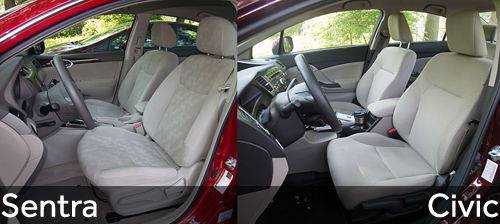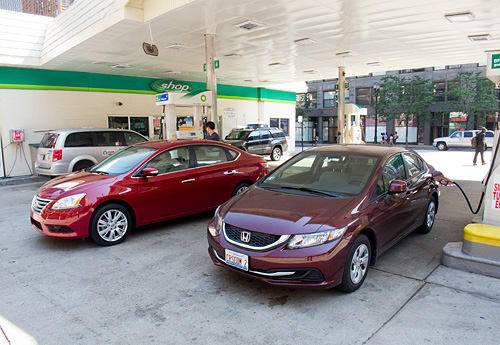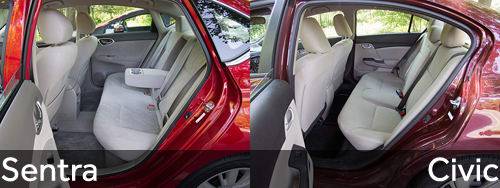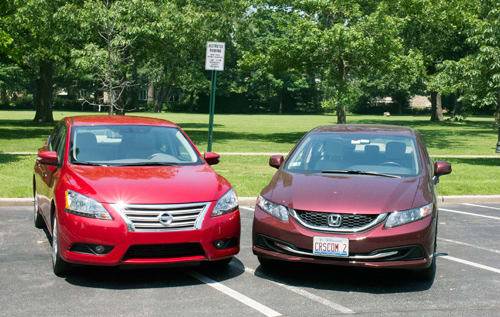2013 Honda Civic Versus 2013 Nissan Sentra


In our makeshift compact-car Olympics, our long-term 2013 Honda Civic has had a bumpy ride. It trounced the outgoing Toyota Corolla but was KIA by a Kia — the brand’s redesigned 2014 Forte. It wasn’t the fairest fight, given our particular Forte test car stickered for considerably more, but then again, so did our test Corolla, which lost big anyway. This time around, we pit the Honda against another redesign: the 2013 Nissan Sentra, a car that went on sale in October 2012. Sentra sales are up 18.7% through June, but the Civic still outsells it by more than a 2-1 ratio — an extension of sales history, where the Civic has thumped the Sentra for the past decade.
Follow Our Long-Term Test Fleet
Sales popularity and strength of product often have little relation, though (see the Corolla review). We received an automatic-equipped Sentra SL, which had a few more features than our Civic LX — most notably dual-zone automatic climate control, alloy wheels and a navigation system. Still, its $21,370 sticker, including destination, came closer to the Civic’s $19,755 than the optioned-out Forte EX or absurdly equipped Corolla S.
We drove the new Sentra in 2012 and came away unmoved, but back-to-back competitive drives always shed more light. Editor Kelsey Mays and Executive Editor Joe Wiesenfelder drove the new Sentra alongside the Civic to find out.

Cabin Quality: Sentra
KM: Nissan designers need to rethink the logic behind padding the dashboard but leaving the upper doors shod in cheap stuff — rather than the other way around — but I still give the Sentra an edge for better materials in often-used areas: cushier door armrests, softer sun visors, chrome door handles. The 2013 Civic has more consistency across all materials, but the Sentra feels richer in the most important areas. It would have spanked the 2012 Civic redesign, but Honda’s emergency interior update narrowed the margins. I think Nissan wins, but only by a nose.
JW: Kelsey makes some good points, but quality is partly about feel and not just how armrests physically feel. The cars have similarly uninspiring cloth upholstery. The Civic’s instruments still impress. The Sentra’s are illuminated but more conventional. I can’t give either car the win here, so I guess Kelsey’s conviction tips it in Nissan’s favor, but not by much.
Noise: Sentra
KM: The Sentra is a quiet experience that soothes the morning commute, and that’s something right up most commuters’ alleys, I suspect.
JW: I agree on the noise levels. Occasionally the continuously variable automatic transmission causes the Sentra’s engine to drone at seemingly inappropriate times, but it’s better than previous generations. Overall, a quieter car.
Ride: Sentra
KM: The Sentra rides softly, if a bit clumsily at times. Despite repeated efforts over the years to refine its character, the Civic is still a noisy, busy-riding car — less so than before, but still in that vein.
JW: If the Sentra rides clumsily, it’s only a little, unlike the Corolla. Definitely softer than the Civic, and I welcome it.
Handling: Civic
KM: After beating the Forte and Corolla, the Civic chalks its third handling win here. Quicker steering and flatter cornering give the Honda a sense of nimbleness that’s missing in the Nissan, whose reflexes seem a touch foggier. We called the redesigned 2012 Civic a bit soft — particularly on the Si front — and Honda responded with a reworked suspension across all models for 2013. Even on our Civic LX, it appears the changes helped.
JW: Another case of a car winning the battle because Kelsey feels strongly in one direction. I think they’re both good, in different ways. The Sentra’s steering isn’t quite as precise as the Civic’s, but I preferred its weight and how well it snaps back to center. Body roll wasn’t too objectionable, and the Sentra has much better roadholding. The Civic’s tires are a weak link.
Acceleration: Civic
KM: Proof again that outdated on paper can still shine on the road: The Civic’s five-speed automatic — one gear shy of most competitors — is a trusty ally. It upshifts smoothly and downshifts without delay, making the most of the Civic’s small four-cylinder. The Sentra’s next-gen CVT, by contrast, shoots for efficiency most of the time. It calls up engine revs soon enough, but small engines demand responsive transmissions, and Honda beats Nissan to the punch here.
JW: Agreed. This CVT improves noticeably over that of the previous generation, making it more acceptable to even more buyers, but the Civic still delivers the goods reliably.
Braking: Civic
KM: Minus the rear disc brakes — an option on the Sentra that our test car lacked — the Nissan stops with squirrely body motions and spongy pedal feedback. The Civic also lacks rear discs below the EX, but pedal feedback is a little better. The Civic wins, but mediocrity reigns.
JW: I’m going to put more support behind the Civic. The Sentra’s brakes felt wrong most of the time. Even with its rear drums, the Civic performs well in normal driving, and that’s what you appreciate most.

Gas Mileage: Sentra
Given that neither car had high-efficiency provisions (Civic HF, Sentra FE+), gas mileage impressed. Without soft-toeing, we still beat the EPA’s combined city/highway ratings, with 35.1 mpg in the Civic and 36.6 mpg in the Sentra. True to its higher EPA combined rating, the Sentra beat the Civic by 1.5 mpg our mileage route. But the difference equates to just $70.06 in annual fuel cost at 15,000 annual miles and $4 a gallon.
Note: Both cars have alternate driving modes (the Civic has Econ; the Sentra has Eco and Sport), but we predominantly drove both in normal Drive. We began our 54-mile loop by filling up both cars with gas. Temperatures were in the mid-80s and winds were less than 10 mph.

Seats and Roominess: Sentra
KM: The Sentra’s front seats could adjust a bit farther rearward for tall drivers, but the backseat and trunk are where the Nissan wins. Backseat space is better, with uniform materials to boot. (The Civic’s cabin quality degrades when you get to the rear doors.) Trunk space? No contest. The Sentra’s 15.1 cubic feet includes a 60/40-split folding rear seat. The Civic LX has a modest 12.5 cubic feet and a single-piece folding backseat (the EX and EX-L get a 60/40-split backseat).
JW: Unlike most compacts, the Sentra’s front seats rival the Civic’s for bottom-cushion length and thigh support, and they don’t have the excessive lumbar support that irks me in the Civic. The Sentra’s center armrest is so far back that it’s practically pointless, but that’s not enough to hurt its competitiveness much (and Nissan says a sliding armrest will be standard in the 2014 Sentra SL and optional in the SV and SR). The Civic is no slouch, but the Sentra definitely has this one in the bag.
Multimedia: Civic
KM: The Sentra’s optional navigation system has user-friendly smartphone cues: You can scroll the map by swiping your finger, for example, instead of pointing at an area to prompt movement. But the Civic’s giant dummy dial — hit it once to adjust volume, again to tune the radio — succeeds in aesthetics and usability. Key information, from vehicle speed to radio stations, sits closer to eye level in the Honda, too. The Sentra may have more bells and whistles, but Honda’s bells are easier to ring.
JW: Yep. Simplicity and clarity win out, and as I said earlier, I’ve become something of a gauge snob, and the Civic’s give a high-quality impression.

Results
In a narrow five-to-four contest, the 2013 Nissan Sentra beat out our long-term Civic in a battle where quiet comfort and fuel economy bested performance and simplicity.
Related
2013 Nissan Sentra Review
2013 Honda Civic Review
More Automotive News

Former Executive Editor Joe Wiesenfelder, a Cars.com launch veteran, led the car evaluation effort. He owns a 1984 Mercedes 300D and a 2002 Mazda Miata SE.
Featured stories




